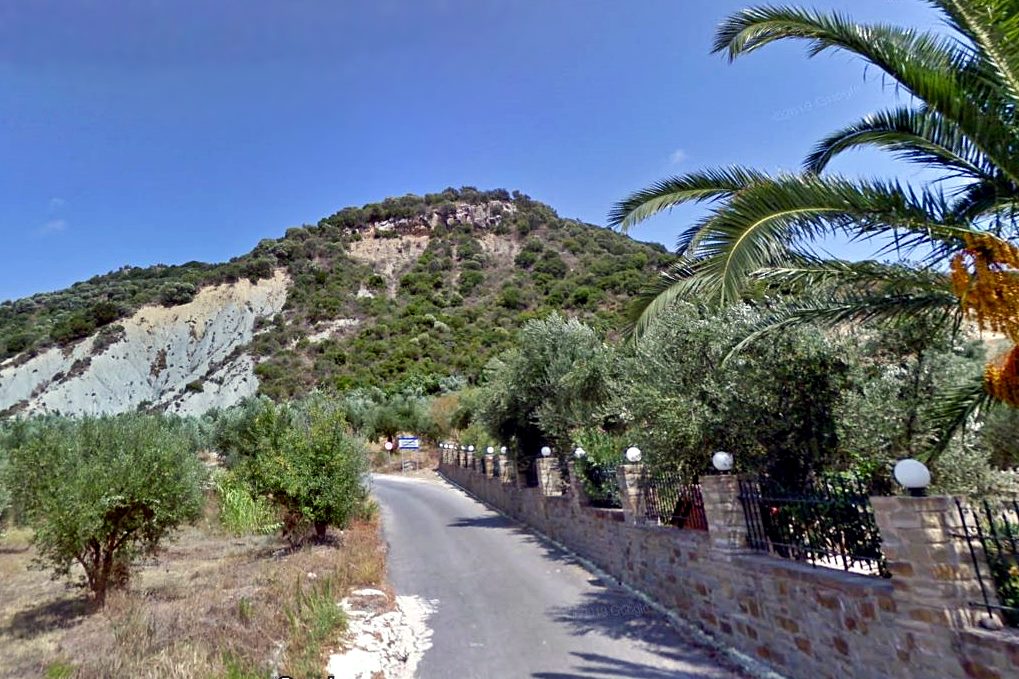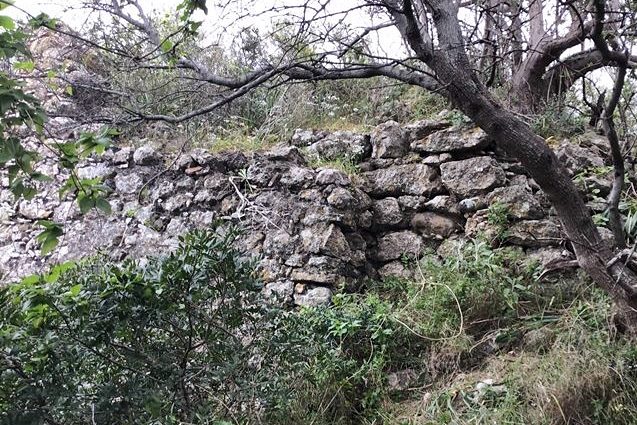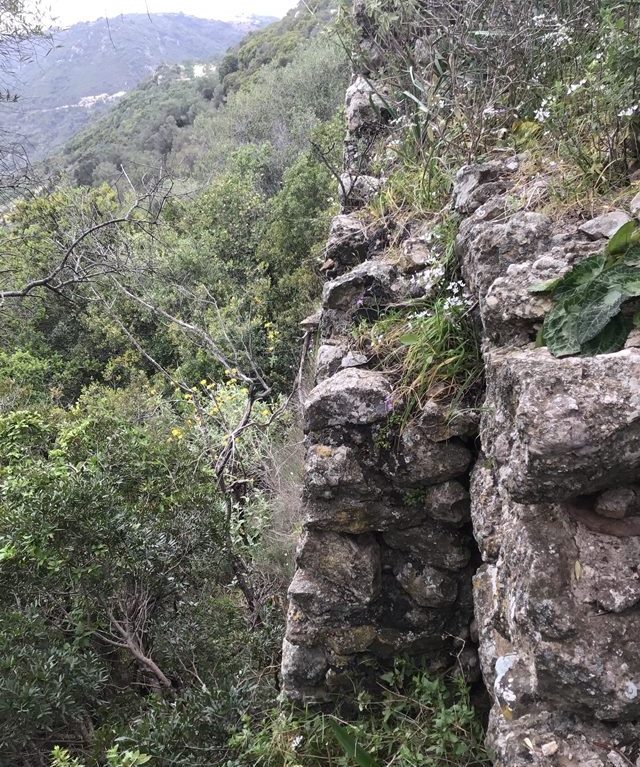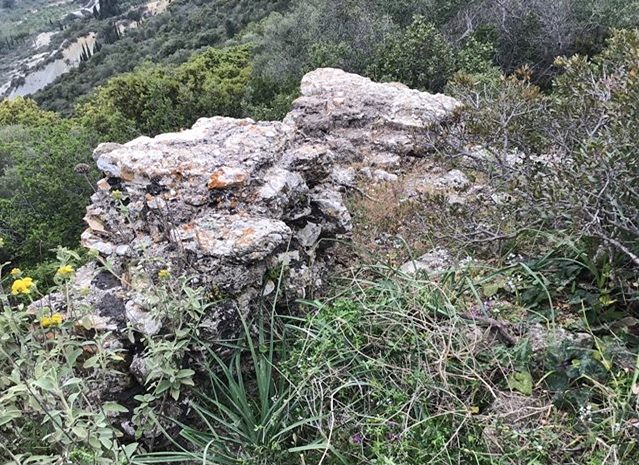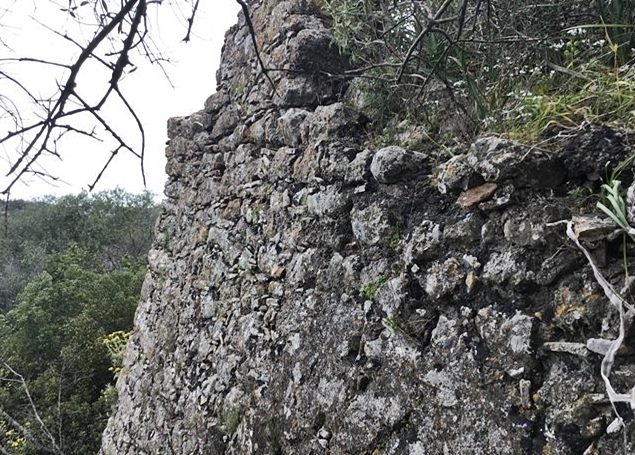Grizocampos, Pylos - Nestor, Messenia,Peloponnese
Grizi castle
| Location: |
| On a hill 700m east of the village Grizocampos of Messinia, 2km north of Akritochori |
| Region > Prefecture: | 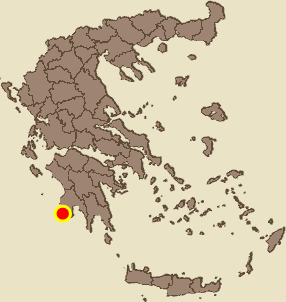 |
| Peloponnese Messenia | |
| Municipality > Town: | |
| City of Pylos - Nestor • Grizocampos | |
| Altitude: | |
|
Elevation ≈ 170 m (Relative Height≈120 m) |
| Time of Construction | Origin | |
| around 1425 | VENETIAN |
|
| Castle Type | Condition | |
| Castle Ruins |
In Ruins
|
Remains of a small fortress of the 15th century built on a hill 2 kilometers north of Akritochori, Messinia. Closer, to the west, is the village of Grizokambos.
History
An ancient fortress from the Hellenistic period previously existed on the hill of the castle. The Swedish researcher M.N.Valmin, who first studied the castle in the 1920s, identified elements of ancient fortification (tower, cisterns), while he found an ancient Greek inscription and coins of the Achaean League.
Regarding the Byzantine period, we do not have any information or traces of habitation on the hill. Later, during the Frankokratia, Grizi was mentioned as a fiefdom and during the Venetian occupation as a castle.
After the capture of Constantinople by the Latins in 1204, and after the conquest of Peloponnese by the knights Champlitte and Villehardouin in 1205, the Pylia peninsula was found to be in the possession of the Franks, while the initial agreement for the partition of Byzantine lands (the Partitio Terrarum) provided that the area would be taken by the Venetians.
Eventually the Latins reached an agreement (Sapienza,1209) according to which the Venetians recognized Frankish rule over most of Pylia, but kept two important ports/castles: Methoni and Koroni.
These ports soon proved valuable to Venice, but there was one problem: the area between Koroni and Methoni did not belong to Venice, and land communication between them was often problematic, as the Franks they were not always willing to facilitate the Venetians.
Grizi was located in this Frankish region between Methoni and Koroni, and relatively closer to Koroni. There are several historical references to Grizi:
In 1338 it was included among the fiefs acquired by the senesal of the Kingdom of Naples and bailiff of the Principality of Achaea [1440-1441] Niccolò Acciaiuoli.
Acciaiuoli at that time had received many lands in the Peloponnese from Catherine de Valois as a reward for his services, but he had also bought many other fiefs by investing his own money. (Grizi was among those purchased.)
Grizi is included again in another list of Acciaiuoli's estate in 1354, and it is also in his will opened after his death in 1365. In 1379 Grizi is still owned by the Acciaiuoli family (his son Angelo). Then it seems that it was somehow passed to the Navarrese company who had prevailed in the Principality.
Here there is an issue because the Grizi of the historical sources is not exactly on the hill of the castle, but is identified with today's Akritohori which is 1.5-2 kilometers to the south. But we must take into account that the fiefs of that time did not include only one village, but a wider area around it. The Grizi of Acciaiuoli certainly reached the hill of the castle and the present-day village of Grizokambos, while on the other side it reached the sea, as in the list of 1354 it is mentioned that Grizi had salt pans (while the current Akritohori is not by the sea).
Strangely, the last will of Acciaiuoli mentions Grizi twice: it has a casale Grisi and shortly after a casale Gricij (casale=village). This double reference may simply have been made by mistake. However, it raises questions. There is a theory that Gricij can be identified with the mysterious barony of Gritsena (unknown location). However, it is possible that the double reference is due to the existence of two settlements in the fief.
Since 1401-1402 Venice began to show interest in acquiring Grizi and other key positions in Pylia. And this for various reasons: the Principality of Achaea was declining fast, Venice was at war with Genoa and felt vulnerable, the Despotate of Mystras was expanding, the Ottomans were becoming more and more threatening on land and sea. In this environment, Venice wanted to strengthen the defense in Messinia which was of strategic importance to its interests.
According to the historian Sathas, in 1403 Venice was ready to pay 1500 ducats to the Franks of the Principality for Grizi. But in 1404 Venice made peace with the Genoese and the plan was temporarily abandoned.
In 1411 the then Prince of Achaia Centyrio II Zaccaria made a proposal to Venice to sell Grizi, Port-de-Jonc (Palionavarino) and Manticori (Maniatochori - unidentified). Centurio, being in very difficult position, sought the alliance of Venice and, moreover, had serious financial problems.
These fiefs were the personal property of the Prince. He had inherited them from his father Andronikos Asan Zaccaria, who had taken them as a dowry as the son-in-law of Pedro of San Superano, the Navarre bailiff of the Principality of Achaia. The Navarre mercenary company had prevailed in the Peloponnese and from 1381 acquired these fiefs (actually, they seized them).
After negotiations and back and forth on both sides, Venice finally acquired in 1423 Grizi, Manitochori and the castle of Palionavarino. The first move of the Venetians was to build an inland road from Koroni to Methoni and build forts to guard it.
In the following decades Grizi was Venetian. When Mohammed the Conqueror finally subdued the Morea in 1460, he did not touch the Venetian possessions at all, and even paid an official visit to Methoni where he was warmly received.
The Venetians built a small fortress in Grizi after 1423, sticking to their plan to strengthen the defense of the important castles and roads in Pylia.
A document of the senate of Venice of 1439 lists the fortresses around the two great castles. 3 castles are mentioned around Methoni and 4 around Koroni, one of which is Grissum. Obviously this is Grizi and this is the only historical reference we have for the existence of a castle there.
In all the above-mentioned historical reports, Grizi is nowhere described as a castle. So we have to take it for granted that the Franks had not built a castle there earlier.
Furthermore, the castle of Grizi is not mentioned in any of the known lists of castles in the Peloponnese. This is strange as it should at least have been included in the Venetian catalogs recording which castles Venice had and which castles had already fallen to the Turks. Perhaps Grizi was not an important fortress, or perhaps it is recorded under another name.
The castle must have fallen into the hands of the Turks early on with the start of the First Venetian-Turkish War (1463-1479). If not then, certainly until 1500, when the Venetians were defeated and left the Peloponnese. It seems that the castle was also used during the Turkish occupation, as M.N.Valmin spotted Turkish additions to the castle. We have not verified this (in Kastrologos) but it is indeed possible that the Turks also used the castle for the same reason as the Venetians: To strengthen the regional defense of Koroni and Methoni.
Structure, Fortification & Buildings
The fort has a maximum length of 60 meters and a width of 35 meters. The interior, where there are ruins of buildings, is divided into two sections by an interior wall.
The maximum surviving height is 5.5m. and is located on the northern side, where an 8✖6m tower is preserved.
On the south side there seems to be an outer enclosure.
The entrance to the fortress was probably in the east, but another entrance can be seen in the southwest side.
There are two cisterns in the castle. According to M.N.Valmin, the tower on the north side and the two cisterns date to the Hellenistic or Roman period.
| First entry in Kastrologos: | May 2023 |
Sources
- Website Αριστομένης ο Μεσσήνιος - Παλαιόκαστρο Γριζόκαμπου Μεσσηνία (Μάιος 2023), φωτογραφίες Βασίλειος Χάντζος
- Γιάννης Μπίρης, website eleftheria - Κάστρα και οχυρά της Μεσσηνίας: Τα κάστρα στο Γρίζι και τη Λαχανάδα
- Antoine Bon, 1969, La Morée franque. Recherches historiques, topographiques et archéologiques sur la principauté d'Achaïe (1205-1430), Editions de Boccard, pp.218,274,275,283-289,291,421,427-429,433-35
- M. N Valmin, Etudes topographiques sur la Messénie ancienne, Lund 1930, σελ. 158
- Matthieu Guintrand. Sparte et la défense du Péloponnèse méridional du milieu du VIe siècle au milieu du IIe siècle av. J.C.. Archéologie et Préhistoire. Université d'Avignon, 2017. p.279
- Brady Kiesling, website ToposText
|
|
| Access |
|---|
| Entrance: |
| Free access |



